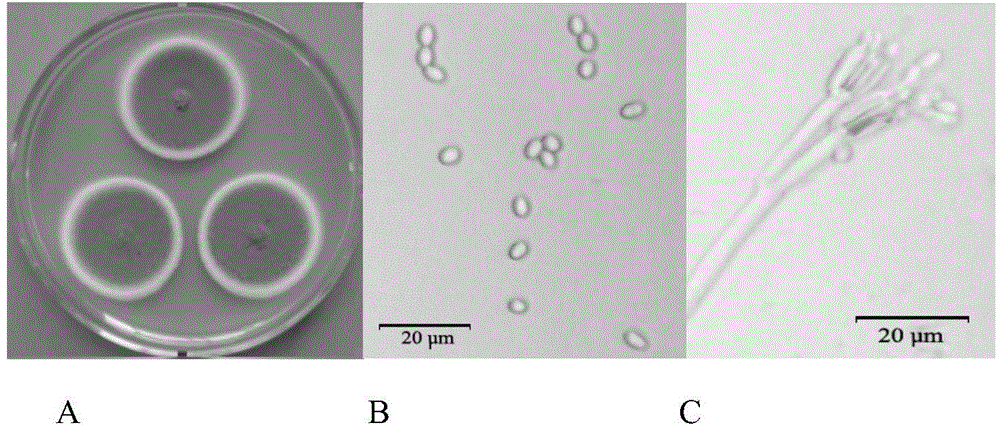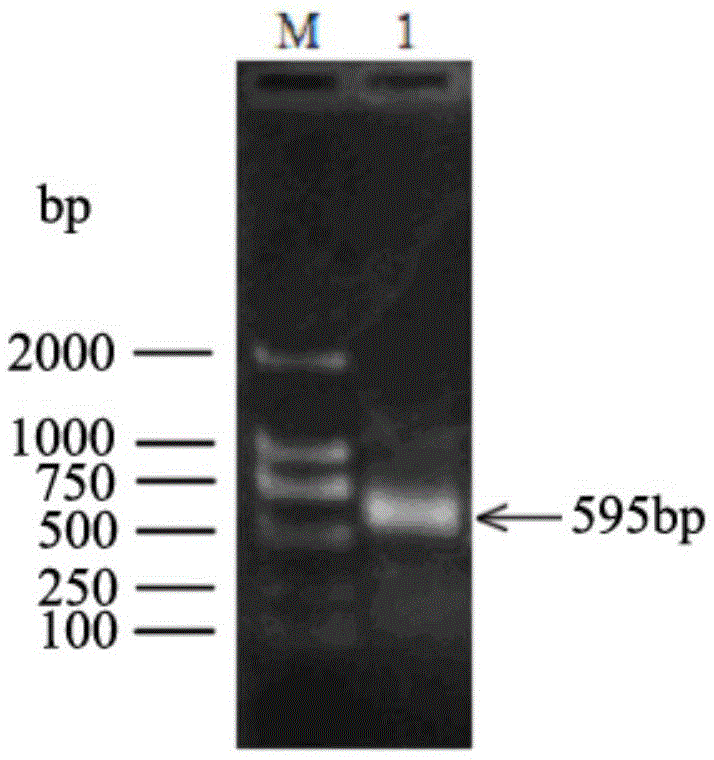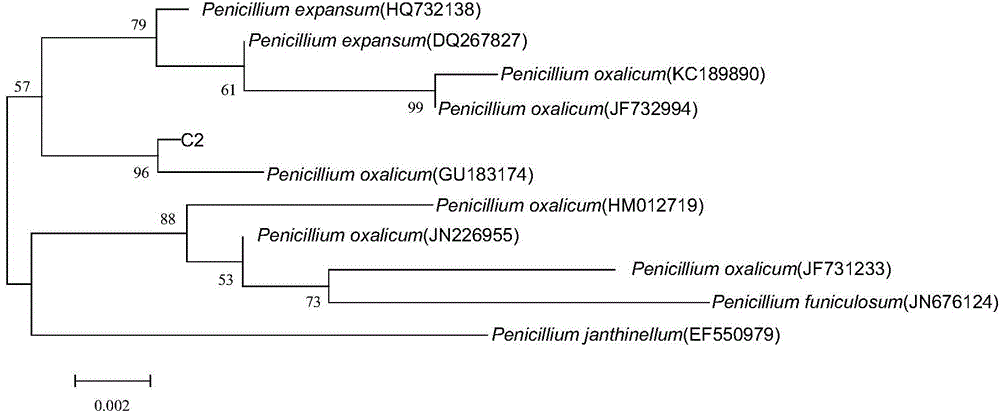Cellulose-degradation fungus and preparation of inoculum and application thereof
The technology of spore inoculum and strain is applied in the field of microorganisms, which can solve the problem that microbial degradation is difficult to achieve the expected effect, and achieve the effects of excellent fermentation properties, low cost and simple fermentation process.
- Summary
- Abstract
- Description
- Claims
- Application Information
AI Technical Summary
Problems solved by technology
Method used
Image
Examples
Embodiment 1
[0042] Enrichment and Isolation of Cellulose Degrading Bacteria
[0043] Take 5g of the humus soil sample collected from the Taishan forestland and add it to 45mL enrichment medium, shake it at 30°C and 180r / min for 3 days, then transfer 5mL culture solution to another triangle filled with fresh enrichment medium Continue to culture in the bottle for 3 days.
[0044] Take the enriched culture solution and dilute it with sterile water to 10 -4 、10 -5 、10 -6 、10 -7 4 concentration gradients. Use a pipette to draw 100 μL of each of the four concentrations of soil dilutions and spread them on the CMC medium plate. Repeat the coating test for each concentration three times, culture at a constant temperature of 28°C for 2 days, and pick a single colony from the medium on the CMC Separation and purification by streaking on the culture medium plate.
[0045] Transfer the strains purified on the CMC medium plate to the cellulose Congo red medium plate. Each strain was replicated ...
Embodiment 2
[0047] 1. Degradation test of filter paper
[0048] Take six 250mL Erlenmeyer flasks, numbered 1-6 respectively; among them, put 1cm×6cm filter paper strips into the 1-3 Erlenmeyer flasks, add 50mL of Hutchinson’s medium to each, and inoculate 1mL The seed solution of cellulose-degrading bacteria C2 was used as the test group; filter paper strips of 1 cm × 6 cm were put into No. As a control group; all six Erlenmeyer flasks were placed in a constant temperature shaker at 30°C, shaken at 200r / min for 5 days, and the filter paper strips in No. 1 to No. 3 Erlenmeyer flasks were visually inspected to form a paste.
[0049] 2. Determination of filter paper cellulase activity
[0050] The present invention uses 3,5-dinitrosalicylic acid (DNS) to react with reducing sugars under alkaline conditions to generate colored compounds, and conduct colorimetric measurement with a spectrophotometer to determine the amount of low-molecular sugars. cellulase activity. The reddish-brown amino...
Embodiment 3
[0065] Identification of Cellulose Degrading Bacteria C2
[0066] 1. Colony characteristics and morphological characteristics of bacteria
[0067] (1) Colony characteristics
[0068] The strain grows rapidly on the PDA plate, the mycelium is dense, the colony is flat, and forms a shell. The mycelium is white at the beginning, and as the cultivation time increases, the mycelium gradually becomes dark green, and the back of the medium is light yellow; The growth on the CMC plate is slow, the mycelium is sparse, the mycelium is also short, the mycelium is flat, and the mycelium is white at the beginning. As the cultivation time increases, the mycelium gradually turns blue-green (see figure 1 ).
[0069] (2) Morphological characteristics of bacteria
[0070] The vegetative mycelium has a septum, the conidiophores grow vertically from the mycelium, and the top grows broom-like interbranches, 7-9 small stalks, (11.5-14.8) μm × (3.0-3.4) μm, conidia Oval, smooth, size (4.8~6.0) μ...
PUM
 Login to View More
Login to View More Abstract
Description
Claims
Application Information
 Login to View More
Login to View More - R&D
- Intellectual Property
- Life Sciences
- Materials
- Tech Scout
- Unparalleled Data Quality
- Higher Quality Content
- 60% Fewer Hallucinations
Browse by: Latest US Patents, China's latest patents, Technical Efficacy Thesaurus, Application Domain, Technology Topic, Popular Technical Reports.
© 2025 PatSnap. All rights reserved.Legal|Privacy policy|Modern Slavery Act Transparency Statement|Sitemap|About US| Contact US: help@patsnap.com



